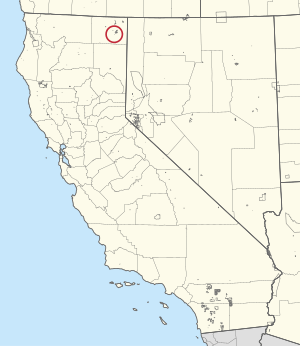Alturas Indian Rancheria facts for kids
Quick facts for kids
Alturas Indian Rancheria
|
|
|---|---|

Location of the Alturas Indian Rancheria
|
The Alturas Indian Rancheria is a special place in California. It is home to a federally recognized tribe of Achomawi (say: Ah-cho-MAH-wee) people. This means the United States government officially recognizes them as a Native American tribe. The tribe controls its own land, called a reservation, near the town of Alturas, California. This land is in Modoc County. The reservation is about 20 acres big. It is located about one mile southeast of downtown Alturas. About 15 people are members of this tribe. The tribe also runs local businesses, like the Desert Rose Casino and the Rose Cafe in Alturas.
Contents
Understanding the World Around Us
The Alturas Indian people have a deep connection to nature. They believe that everything around us has life. This includes trees, rocks, mountains, and water. Even things you might think are not alive, like a rock, are full of life to them.
One elder, Katsumahtauta, explained this idea. He said that when he visits a new place, he talks to everything around him. He sends his smoke to make friends with all things. He believes that stones and trees can talk to each other, just like people do. If you listen closely, especially at night, you might hear them. This belief shows how much they respect and care for the natural world. They believe that if they take care of nature, nature will take care of them.
Language and Heritage
The Achomawi people are also known as the Pit River Indians. For a long time, they spoke their own special language, called the Achumawi language. It is a unique language that connects them to their ancestors.
However, over time, fewer people have learned to speak Achumawi. Many younger generations of Alturas Indians now speak English as their main language. Efforts are often made to keep traditional languages alive. This helps preserve the tribe's rich cultural heritage.
Education for the Future
The children and young people living on the Alturas Indian Rancheria attend local schools. The Modoc Joint Unified School District serves the ranchería. This school district provides education for students in the area. It helps them learn and grow, preparing them for their future.
Traditions and Daily Life
Many of the old traditions and ceremonies of the Alturas Indians are not widely known today. However, some important practices have been shared.
- Becoming an Adult: When boys and girls reached adulthood, they had their ears pierced. This was a special ceremony.
- Coming-of-Age Rituals: Boys would go into the mountains alone for a night. Girls had a different tradition. They would dance and sing for 10 nights. These rituals helped them transition into adult roles in the tribe.
- Traditional Clothing: Men wore clothes like skirts made from animal hides. Women wore shorts and skirts, often made from deer-hide. Sometimes, men also wore leggings and moccasins made from the same materials. If deer-hide was not available, they used shredded cedar bark.
- Body Art: Women sometimes had tattoos on their faces. Men would pierce their noses to wear a shell or bone. These were ways to decorate themselves and show their identity.
- Food: Their diet was similar to other Native American tribes in Northern California. They ate a lot of acorns, which they processed into food. Deer meat was also a very important part of their diet. They also ate salmon, which they caught from rivers.

